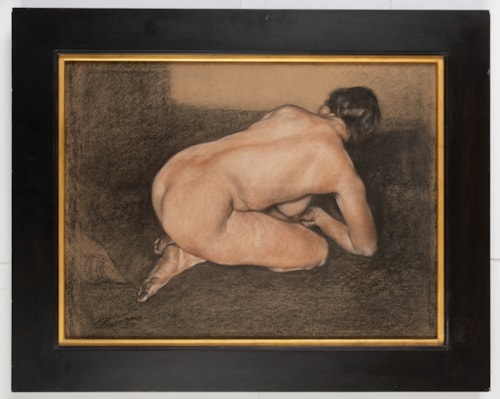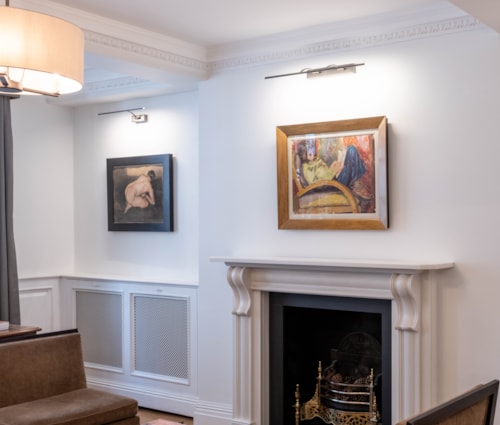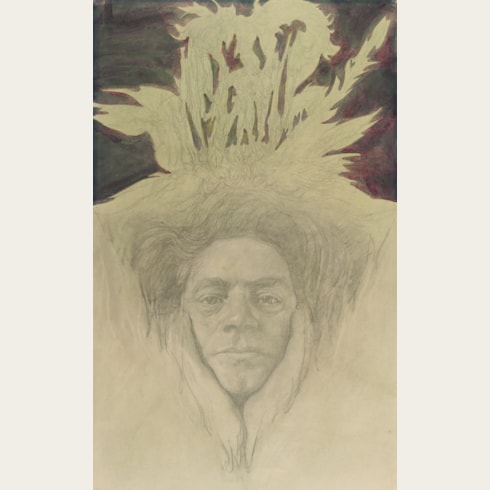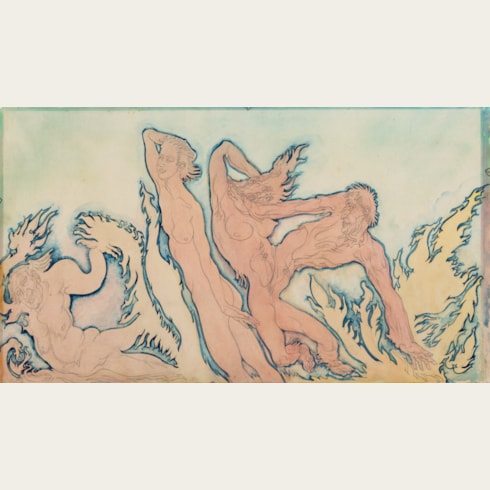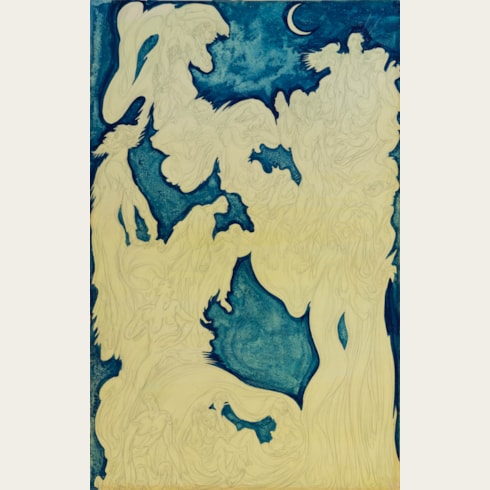Austin Osman SPARE
(London 1886 - London 1956)
A Crouching Female Nude, Seen from Behind
Pastel.
Indistinctly signed or inscribed in charcoal at the lower left.
448 x 607 mm. (17 5/8 x 23 7/8 in.)
Indistinctly signed or inscribed in charcoal at the lower left.
448 x 607 mm. (17 5/8 x 23 7/8 in.)
The very large sheet may be dated to the early 1920s, when Spare produced a number of drawings of female nudes characterized by an uncompromising realism. A closely comparable large-scale pastel study of a crouching female nude seen from the front, signed and dated 1923 and of slightly smaller dimensions, is in a private collection
The model for many of Spare’s drawings of nudes of this period seems to have been a woman named Freda, of whom little else is known. Several nude studies of her appeared in the first few issues of a journal entitled The Golden Hind: A Quarterly Magazine of Art and Literature, founded in 1922 and edited by Spare and the writer Clifford Bax, and issued in a large-scale folio format. As the artist’s biographer Phil Baker has noted, ‘The first issue of The Golden Hind appeared in October 1922, and included a large lithograph by Spare entitled ‘The New Eden’: Spare’s head, bat-winged, appeared in the sky over a realistically fleshy Freda, crouching naked near a coiled snake…As Bax remembered it, Spare “innocently filled our first number with…backviews of massive nude females”, and this caused their journal to be nicknamed The Golden Behind.’ The magazine lasted for just eight issues, and ceased publication in 1924.
The present sheet also displays some similarities with a similar study of the back of a seated female nude, of vertical format and dated 19209. This was one of several similar drawings of female nudes used to illustrate Spare’s fourth book The Focus of Life, on which he worked for several years before its publication in 1921. Similar crouching figures also occur elsewhere in Spare’s work, such as a drawing entitled Metamorphosis of c.1926, which appeared at auction in London in 1994. As Baker writes, ‘Spare loved the flesh, perfect and imperfect, and among the idealised nudes there are other women who are more realistically naked. This was a lifelong tendency, increasing as he grew older and started to use elderly local women for models…His friend Dennis Bardens remarks that “His nudes were sometimes idyllic, sometimes earthy”…’
The model for many of Spare’s drawings of nudes of this period seems to have been a woman named Freda, of whom little else is known. Several nude studies of her appeared in the first few issues of a journal entitled The Golden Hind: A Quarterly Magazine of Art and Literature, founded in 1922 and edited by Spare and the writer Clifford Bax, and issued in a large-scale folio format. As the artist’s biographer Phil Baker has noted, ‘The first issue of The Golden Hind appeared in October 1922, and included a large lithograph by Spare entitled ‘The New Eden’: Spare’s head, bat-winged, appeared in the sky over a realistically fleshy Freda, crouching naked near a coiled snake…As Bax remembered it, Spare “innocently filled our first number with…backviews of massive nude females”, and this caused their journal to be nicknamed The Golden Behind.’ The magazine lasted for just eight issues, and ceased publication in 1924.
The present sheet also displays some similarities with a similar study of the back of a seated female nude, of vertical format and dated 19209. This was one of several similar drawings of female nudes used to illustrate Spare’s fourth book The Focus of Life, on which he worked for several years before its publication in 1921. Similar crouching figures also occur elsewhere in Spare’s work, such as a drawing entitled Metamorphosis of c.1926, which appeared at auction in London in 1994. As Baker writes, ‘Spare loved the flesh, perfect and imperfect, and among the idealised nudes there are other women who are more realistically naked. This was a lifelong tendency, increasing as he grew older and started to use elderly local women for models…His friend Dennis Bardens remarks that “His nudes were sometimes idyllic, sometimes earthy”…’
Arguably one of the most gifted draughtsmen of Edwardian London, and today perhaps among the least well-known, Austin Osman Spare was born in Smithfield in London - a true Cockney - on the penultimate day of 1886. He drew constantly from a very early age, and by the end of his life had produced over two thousand drawings, watercolours and pastels. Although he was largely self-taught, from the age of about twelve he took evening classes at the Lambeth School of Art, where his fellow pupils included Glyn Philpot. Among his early artistic influences were Aubrey Beardsley and George Frederick Watts, and he was also a voracious reader, particularly of the Theosophical writings of Madame Blavatsky. In 1903 Spare won a silver medal in the National Competition of Schools of Art, representing Lambeth, and the following year a first exhibition of his drawings was held at the public library in Newington. Likewise in 1904, the seventeen-year-old Spare had a drawing accepted at the Royal Academy Summer Exhibition, becoming one of the youngest exhibitors ever. This earned him much comment and praise as something of a ‘boy genius’ from journalists and critics, as well as, it is said, from such fellow artists as Watts, Augustus John and John Singer Sargent. Having been recommended by the artist William Blake Richmond for a scholarship to the Royal College of Art, Spare found the institution unsuited to his style and temperament, and soon began skipping classes. He left the school in 1905, without any qualifications, and the same year self-published Earth: Inferno; his first book of drawings and mystical texts (‘Strange Desires and Morbid Fancies’, in his words). Another of his drawings was shown at the Royal Academy in 1905, and at around the same time began to work as a book illustrator and a designer of bookplates. In 1907 a second volume of Spare’s drawings was published, entitled A Book of Satyrs and containing eleven striking images of satirical subjects.
Spare had his first proper exhibition at the Bruton Gallery in London in 1907. ‘Black and White Drawings by Austin O. Spare’ resulted in a number of reviews, most of which commented equally on the sheer technical proficiency of the works and their weird and disturbing subject matter. As one reviewer noted, the exhibition ‘will probably be the talk of the London studios for many a day to come. In speaking of his pen and ink work it is difficult to avoid superlatives. His craftsmanship is superb; his management of line has not been equalled since the days of Aubrey Beardsley; his inventive faculty is stupendous and terrifying in its creative flow of impossible horrors.’ It was at the Bruton Gallery that Spare first met the occultist Aleister Crowley, who joined a small but growing band of patrons and collectors of the young artist’s work, notably the designer Pickford Waller. Spare, who had a lifelong interest in the occult, provided a number of illustrations for Crowley’s journal The Equinox. Further exhibitions of his drawings in West End galleries followed in 1911, 1912 and 1914, while in 1913 Spare’s The Book of Pleasure (Self-Love): The Psychology of Ecstasy was self-published.
In 1916 Spare founded and co-edited the magazine Form: A Quarterly of the Arts. Lavishly produced but also criticized for its eccentric layout, the journal lasted for only two issues before it ceased publication with the outbreak of the First World War, when Spare was conscripted into the Royal Army Medical Corps and worked as an Official War Artist. The journal was briefly revived after the war but Spare soon moved on to a new project, a literary and artistic journal called The Golden Hind, which ran for eight issues, until 1924. By now he was living in relative squalor in a council flat in Borough in South London, and his next project was an album of ‘automatic’ grotesque drawings, entitled The Book of Ugly Ecstasy, of which the sole copy was purchased in 1924 by the art historian Gerald Reitlinger. (His brother, the Old Master drawing collector Henry Scipio Reitlinger, also acquired some drawings by Spare in the 1920s.) Although Spare was producing some of his best drawings by the end of the 1920s, exhibitions of his work at the St. George’s Gallery in Hanover Square in 1927 and at Alex. Reid and Lefevre in 1929 were commercial and critical failures, as was a 1930 show of anamorphic portraits in watercolour (which the artist titled ‘Experiments in Relativity’) at a gallery in St. James’s, which was to be his final West End exhibition. By this time, Spare had begun to exhibit and sell his drawings from his South London flat, and had fallen into something of a depression.
Spare moved in 1936 to a large but spartan studio space near the Elephant and Castle in London, where he was able to hold exhibitions of his work, and where he began a School of Draughtsmanship. The same year he received a most unusual request; to paint the portrait of Adolf Hitler in Berlin. Apparently, someone at the German embassy in London had purchased a portrait or self-portrait by Spare and had sent it to the Führer as a present. (The work in question may even have been a self-portrait of the artist ‘as Hitler’, since Spare had a similar small moustache at this time.) Hitler was, it seems, impressed enough by Spare’s talent to offer to fly the artist to Germany, but the artist brusquely rejected the proposed commission.
In May 1941 Spare’s studio was completely destroyed by a German bomb, resulting in the loss of everything he owned, including several hundred works. His right arm was severely injured, so that he was unable to draw for several months, and he also suffered from memory loss. Soon living in a tiny basement room in Brixton in abject poverty, dressed in tattered clothes and sleeping on two chairs since he had no bed, Spare nevertheless continued to draw, filling sketchbook after sketchbook with drawings. An exhibition at the Archer Gallery in Westbourne Grove in 1947 was a great success, and from 1949 onwards Spare began to hold exhibitions in a series of South London pubs; The Temple Bar in 1949, The Mansion House in 1952 and The White Bear in 1953. He remained quite impecunious, however, largely due to his refusal to produce commercial portraits. He turned down numerous requests for portrait commissions, once remarking to his friend and acolyte Kenneth Grant, ‘I can only do portraits in the quiet of my own rooms…with the best intentions I don’t know how I should get a drawing board and easel to any particular place and at a certain time. Which is the reason I have never troubled to do portraits for a living – but tramps, charwomen, etc…Studies of heads - Yes! But with no thought of sale – that would kill me at once.’ He remained intensely prolific until the end of his life, however, and his last exhibition, at the Archer Gallery in 1955, included over 220 works. The following year, on the 15th of May, Spare – already in poor health - died from peritonitis following a burst appendix, at the age of sixty-nine. That evening, a newspaper noted that ‘A strange and gentle genius died in a London hospital this afternoon. You have probably never heard of Austin Osman Spare. But his should have been a famous name.’
Works by Austin Osman Spare are today in the collections of the British Museum, the National Portrait Gallery, the Victoria and Albert Museum, the South London Gallery and the Imperial War Museum in London, as well as the Ashmolean Museum in Oxford, the City Art Gallery in Manchester and the National Museum of Wales in Cardiff.
As the contemporary writer and graphic novelist Alan Moore has noted, ‘In his relation to both art and occultism, Austin Osman Spare stands out as a strikingly individual and even unique figure in fields that are by their very nature brimming with strikingly individual figures.’
Spare had his first proper exhibition at the Bruton Gallery in London in 1907. ‘Black and White Drawings by Austin O. Spare’ resulted in a number of reviews, most of which commented equally on the sheer technical proficiency of the works and their weird and disturbing subject matter. As one reviewer noted, the exhibition ‘will probably be the talk of the London studios for many a day to come. In speaking of his pen and ink work it is difficult to avoid superlatives. His craftsmanship is superb; his management of line has not been equalled since the days of Aubrey Beardsley; his inventive faculty is stupendous and terrifying in its creative flow of impossible horrors.’ It was at the Bruton Gallery that Spare first met the occultist Aleister Crowley, who joined a small but growing band of patrons and collectors of the young artist’s work, notably the designer Pickford Waller. Spare, who had a lifelong interest in the occult, provided a number of illustrations for Crowley’s journal The Equinox. Further exhibitions of his drawings in West End galleries followed in 1911, 1912 and 1914, while in 1913 Spare’s The Book of Pleasure (Self-Love): The Psychology of Ecstasy was self-published.
In 1916 Spare founded and co-edited the magazine Form: A Quarterly of the Arts. Lavishly produced but also criticized for its eccentric layout, the journal lasted for only two issues before it ceased publication with the outbreak of the First World War, when Spare was conscripted into the Royal Army Medical Corps and worked as an Official War Artist. The journal was briefly revived after the war but Spare soon moved on to a new project, a literary and artistic journal called The Golden Hind, which ran for eight issues, until 1924. By now he was living in relative squalor in a council flat in Borough in South London, and his next project was an album of ‘automatic’ grotesque drawings, entitled The Book of Ugly Ecstasy, of which the sole copy was purchased in 1924 by the art historian Gerald Reitlinger. (His brother, the Old Master drawing collector Henry Scipio Reitlinger, also acquired some drawings by Spare in the 1920s.) Although Spare was producing some of his best drawings by the end of the 1920s, exhibitions of his work at the St. George’s Gallery in Hanover Square in 1927 and at Alex. Reid and Lefevre in 1929 were commercial and critical failures, as was a 1930 show of anamorphic portraits in watercolour (which the artist titled ‘Experiments in Relativity’) at a gallery in St. James’s, which was to be his final West End exhibition. By this time, Spare had begun to exhibit and sell his drawings from his South London flat, and had fallen into something of a depression.
Spare moved in 1936 to a large but spartan studio space near the Elephant and Castle in London, where he was able to hold exhibitions of his work, and where he began a School of Draughtsmanship. The same year he received a most unusual request; to paint the portrait of Adolf Hitler in Berlin. Apparently, someone at the German embassy in London had purchased a portrait or self-portrait by Spare and had sent it to the Führer as a present. (The work in question may even have been a self-portrait of the artist ‘as Hitler’, since Spare had a similar small moustache at this time.) Hitler was, it seems, impressed enough by Spare’s talent to offer to fly the artist to Germany, but the artist brusquely rejected the proposed commission.
In May 1941 Spare’s studio was completely destroyed by a German bomb, resulting in the loss of everything he owned, including several hundred works. His right arm was severely injured, so that he was unable to draw for several months, and he also suffered from memory loss. Soon living in a tiny basement room in Brixton in abject poverty, dressed in tattered clothes and sleeping on two chairs since he had no bed, Spare nevertheless continued to draw, filling sketchbook after sketchbook with drawings. An exhibition at the Archer Gallery in Westbourne Grove in 1947 was a great success, and from 1949 onwards Spare began to hold exhibitions in a series of South London pubs; The Temple Bar in 1949, The Mansion House in 1952 and The White Bear in 1953. He remained quite impecunious, however, largely due to his refusal to produce commercial portraits. He turned down numerous requests for portrait commissions, once remarking to his friend and acolyte Kenneth Grant, ‘I can only do portraits in the quiet of my own rooms…with the best intentions I don’t know how I should get a drawing board and easel to any particular place and at a certain time. Which is the reason I have never troubled to do portraits for a living – but tramps, charwomen, etc…Studies of heads - Yes! But with no thought of sale – that would kill me at once.’ He remained intensely prolific until the end of his life, however, and his last exhibition, at the Archer Gallery in 1955, included over 220 works. The following year, on the 15th of May, Spare – already in poor health - died from peritonitis following a burst appendix, at the age of sixty-nine. That evening, a newspaper noted that ‘A strange and gentle genius died in a London hospital this afternoon. You have probably never heard of Austin Osman Spare. But his should have been a famous name.’
Works by Austin Osman Spare are today in the collections of the British Museum, the National Portrait Gallery, the Victoria and Albert Museum, the South London Gallery and the Imperial War Museum in London, as well as the Ashmolean Museum in Oxford, the City Art Gallery in Manchester and the National Museum of Wales in Cardiff.
As the contemporary writer and graphic novelist Alan Moore has noted, ‘In his relation to both art and occultism, Austin Osman Spare stands out as a strikingly individual and even unique figure in fields that are by their very nature brimming with strikingly individual figures.’
Provenance
Arnold Klein Gallery, Royal Oak, Michigan
Frederick J. Cummings, Detroit and New York
His posthumous sale, New York, Christie’s East, 12 July 1994, lot 270
Private collection
Anonymous sale, New York, Swann Galleries, 19 September 2017, lot 482
Private collection, London.
Frederick J. Cummings, Detroit and New York
His posthumous sale, New York, Christie’s East, 12 July 1994, lot 270
Private collection
Anonymous sale, New York, Swann Galleries, 19 September 2017, lot 482
Private collection, London.
Exhibition
Binghamton, State University of New York, University Art Gallery, New York, Finch College Museum of Art, and Williamstown, Sterling and Francine Clark Art Institute, Strictly Academic: Life Drawing in the Nineteenth Century, 1974.



